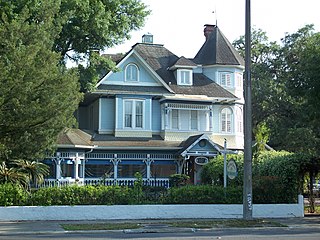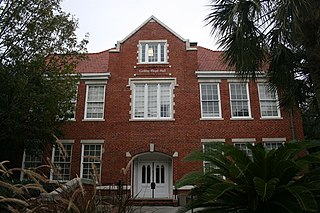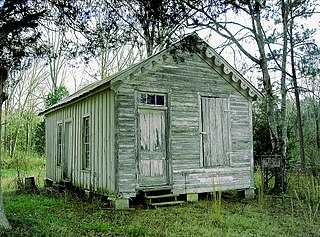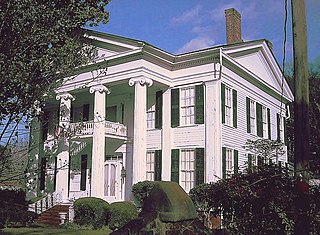
Gainesville is a town in Sumter County, Alabama, United States. Founded in 1832, it was incorporated in 1835. At the 2010 census the population was 208, down from 220. Confederate Lieutenant General Nathan Bedford Forrest surrendered his men near Gainesville on May 19, 1865, at the Civil War's end.

Bride's Hill, known also as Sunnybrook, is a historic house near Wheeler, Alabama. It is one of the state's earliest surviving and most significant, examples of the Tidewater-type cottage. It was added to the Alabama Register of Landmarks and Heritage on April 16, 1985 and to the National Register of Historic Places on July 9, 1986.

The Mary Phifer McKenzie House, now the Sweetwater Branch Inn Bed and Breakfast, is an historic house located at 617 East University Avenue in Gainesville, Florida. It was added to the National Register of Historic Places in 1982.

Griffin–Floyd Hall is a historic academic building located on the northeastern portion of the University of Florida campus in Gainesville, Florida. On June 27, 1979, it was added to the U.S. National Register of Historic Places. It currently houses the Department of Philosophy and Department of Statistics.

Allen Grove is a plantation house and historic district located in Old Spring Hill, Alabama. The Greek Revival house was built for John Gray Allen in 1857 by David Rudisill. It is a two-story frame structure with a two-story front portico featuring square paneled columns. The roof is hipped with side dormers. In 1890 the rear facade was altered when a kitchen and pantry wing and a two-story back porch was added. The house and two other plantation buildings were added to the National Register of Historic Places on July 7, 1994, as a part of the Plantation Houses of the Alabama Canebrake and Their Associated Outbuildings Multiple Property Submission.

The Dickinson House is a historic house in Grove Hill, Alabama. The two-story Italianate style house was built in 1845. It was designed by James Newman. It was added to the Alabama Register of Landmarks and Heritage on January 1, 1978 and to the National Register of Historic Places on September 13, 1978. The house was listed due to its architectural significance as an early example of Italianate architecture.

The Cobb House is a historic house near Grove Hill, Alabama. The two-story I-house was built in 1865. It was added to the Alabama Register of Landmarks and Heritage on January 29, 1980 and subsequently to the National Register of Historic Places on July 28, 1999. It was listed due to its architectural significance as a part of the Clarke County Multiple Property Submission.

The Paterson House is a historic residence in Mobile, Alabama, United States. The 8,000-square-foot (740 m2) Mediterranean Revival style house was completed in 1927. It was designed by local architect Platt Roberts, who later designed Mobile's 16-story Waterman Building. It was added to the National Register of Historic Places on May 15, 1986, based on its architectural significance.

The Gainesville Historic District is a historic district that encompasses a historic section of Gainesville, Alabama, United States. The district was listed on the Alabama Register of Landmarks and Heritage on March 25, 1976 and the National Register of Historic Places on October 3, 1985. The district covered 76 acres (31 ha) and contained 24 historically significant contributing properties when first listed.

Aduston Hall is a historic antebellum plantation house in the riverside town of Gainesville, Alabama. Although the raised cottage displays the strict symmetry and precise detailing of the Greek Revival style, it is very unusual in its massing. The house is low and spread out over one-story with a fluid floor-plan more reminiscent of a 20th-century California ranch house than the typically boxy neoclassical houses of its own era.
This is a list of the 26 multiple property submissions on the National Register of Historic Places in Alabama. They contain more than 288 individual listings of the more than 1,200 on the National Register in the state.

The Coffin Shop, also known as the Kring Carpenter Shop, is a historic commercial building in Gainesville, Sumter County, Alabama. The one-story wood-frame structure was built by Edward N. Kring between 1860 and 1870 as an auxiliary space to his carpenter shop, which originally stood next door. It is a simple gable-fronted structure, with a shotgun plan interior. The exterior features a clapboard-sided front, with a scalloped bargeboard trim on the gable. The other external walls are covered in board and batten siding. It was added to the National Register of Historic Places on October 29, 1985.

The Gibbs House is a historic house in Gainesville, Sumter County, Alabama. The one-story wood-frame structure was built for Hawkins Gibbs from 1860–61. The vernacular Greek Revival style house features a main central block with a side-gable roof, flanked by front-gabled wings to either side. The front facade of the main block features a full-width porch, set under the main roof. A similar version of this arrangement, largely unique to the Gainesville area in Alabama, is seen at Aduston Hall and a number of other nearby houses. It was added to the National Register of Historic Places on October 3, 1985.

The Main–Yankee Street Historic District is a historic district that encompasses an antebellum residential section of Gainesville, Sumter County, Alabama. The district was listed on the National Register of Historic Places on October 3, 1985. It covers 6.5 acres (2.6 ha) and contains five historically significant contributing properties, all predating the American Civil War.

The Colonel Green G. Mobley House, also known as The Magnolia, is a historic house in Gainesville, Sumter County, Alabama. The two-story wood-frame house was built for Colonel Green G. Mobley, a native of Fairfield County, South Carolina, and his wife Henrietta, a native of Vermont. The Greek Revival-style structure was completed circa 1845. Architectural historians consider it to be among West Alabama's most refined expressions of domestic Greek Revival architecture.

The Gainesville Park and Bandstand is a historic park and bandstand in Gainesville, Sumter County, Alabama. The bandstand is a Greek Revival-style pavilion, built circa 1850. It is a rare Alabama example of an enduring mid-19th century park structure. The entire park is surrounded by 19th century wrought iron fence. The park and bandstand were listed on the National Register of Historic Places on October 29, 1985.

The Laura Watson House was a historic house in Gainesville, Sumter County, Alabama. The one-story, wood frame, spraddle roof house was built for Laura Watson and her son, Booker, circa 1900. It was significant as a surviving example of what was once a typical type of dwelling for small African American freeholders in Alabama. It was added to the National Register of Historic Places on October 3, 1985.

The Hugh Wilson Hill House, also known as the Kelly-Stone-Hill House, is a historic house in Carrollton, Pickens County, Alabama. It is one of only a few surviving antebellum structures remaining in the town. Architectural historians believe that the one-story Greek Revival-style house was built for Isham and Elizabeth Kelly during the late 1830s or 1840s. Confederate general John Herbert Kelly grew up in the house. It was added to the National Register of Historic Places on April 13, 1989. It was listed as one of Alabama's "Places in Peril" for 2010 by the Alabama Historical Commission and Alabama Trust for Historic Preservation.

The Stewart–Blanton House was a historic house on State Route 86 near Carrollton, Pickens County, Alabama. The two-story Greek Revival-style house was built between 1840 and 1850 for Charles Stewart, an early religious and political leader in the county. The house was five bays wide, with a two-story tetrastyle portico over the center bay. It was added to the National Register of Historic Places on May 23, 1985.

Fort Perry is the site of a historic stockade fort defended by block houses in the area of Box Springs, Georgia. It was built in 1813 along the Old Federal Road. The site is commemorated by a historical marker located nearby on Fort Perry Road. It was constructed under General John Floyd and was used as a base of attack on the Sticks tribe. The fort was named for Oliver Hazard Perry. Fort Perry was added to the National Register of Historic Places on July 30, 1975.

















